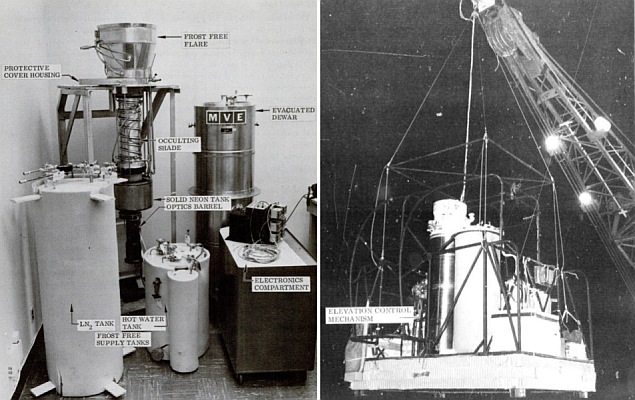Purpose of the flight and payload description
The objective of the flight was to measure the atmospheric emission in the 8 to 13 micrometers wavelength range using an infrared radiometer capable of operation from a balloon platform. Those studies were of interest to determine the magnitude of the background for stellar observations and to determine the time or spatial variations in gaseous or aerosol compositions. The radiometer system was designed and fabricated by the Lockheed Missiles & Space Company (LMSC), Palo Alto Research Laboratory under contract with the Defense Advanced Research Projects Agency of the Department of Defense and monitored by Air Force Cambridge Research Laboratories (AFCRL).
In the image at left we can see the main elements that form the system while at right the image show the Radiometer in its balloon gondola before flight (click to enlarge). IR radiometers usually flown in balloons use liquid cryogens, but the system described here was the first one that used a solid cryogen cooled optical system. Its unique double focus design provided a large total field of view (8 degrees) with high out-of-field energy rejection and an optical resolution that approached the diffraction limit for a 12.7 centimeter aperture. A four-detector Hg:Ge array with eight spectral filters provided spectral coverage from 8 to 13 micrometers.
The electronic, optical, and cooling systems were designed to stand the prelaunch handling of the gondola, remote operation for balloon flights up to 9 hours, and the shock and unattended shutdown on landing. A variation in background emission of about five orders of magnitude was accommodated by a logarithmic amplifier and neutral density filters. Twenty-eight volts of dc power was provided by nickel silver batteries. The system design included a liquid nitrogen (LN2) cooled occulting shade located forward of the optical train. The shade and first optical element were covered by a motorized movable cover to protect the optical system from condensation at low altitudes and as a temperature calibration source during flight. The optical train and detectors were conductively and radiatively cooled by solid neon formed in a toroidal tank attached to the aluminum optical barrel. The entire optical assembly and neon tank were enclosed in an LN2 jacketed double evacuated Dewar.
A frost-free optical system was assured during flight by purging the optical volume with the neon vent gas and mixing the neon gas and warm nitrogen gas at the shade aperture before expulsion to the ambient environment. A separate LN2 tank, a heat exchanger, and a hot water tank were carried aloft with the balloon to supply the warm nitrogen gas. The radiometer and Dewar assembly were mounted on a gimbal system operated as part of the gondola equipment to remotely control the viewing angle at 90 degrees (vertical); 45, 30, 15, 10, 5, and 0 degrees (horizontal); or -5 degrees.
The radiometer assembly, telemetry, tape recorders, storage tanks, batteries, and ballast were mounted on the gondola platform that measured 1.67 meters by 2.36 meters. The radiometer Dewar was mounted to the worm gear-driven gimbal system near its center of gravity for ease of rotation and to maintain the gondola in a horizontal position during flight when the radiometer was rotated downward.
A more detailed description of this complex system can by found in the references at the end of this page.
Details of the balloon flight
Balloon launched on: 6/8/1971 at 23:53 mdt
Launch site: Holloman Air Force Base, Alamogordo, New Mexico, US
Balloon launched by: Air Force Cambridge Research Laboratories (AFCRL)
Balloon manufacturer/size/composition: Zero Pressure Balloon
End of flight (L for landing time, W for last contact, otherwise termination time): 6/9/1971 at 9:56 mdt
Landing site: Near Socorro, New Mexico, US
This was the second flight of the AFCRL-LMSC refractive optics radiometer. The balloon was launched from Holloman Air Force Base at 23:53 mdt on June 8, 1971. After a nominal ascent phase float altitude of 91,700 ft was reached at 2:44 mdt. After scientific portion of the mission was over the flight was terminated at 9:56 mdt. Impact occurred near Socorro, New Mexico. Payload was returned to Holloman AFB on June 9, 1971 and after a preliminary inspection, it was found to be in good condition.
External references
- Infrared Radiometer Experiment Final rept. 1 Aug 1969-9 Mar 1972, Lockheed Missiles & Space Company
- Operation of a Cryogenically Cooled Infrared Radiometer from a Balloon Platform Proceedings, Seventh AFCRL Scientific Balloon Symposium (1973) p. 351
16004If you consider this website interesting or useful, you can help me to keep it up and running with a small donation to cover the operational costs. Just the equivalent of the price of a cup of coffee helps a lot.


